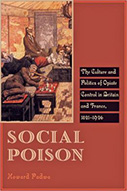Social Poison: The Culture and Politics of Opiate Control in Britain and France, 1821-1926

Author: Howard Padwa
Publisher: Baltimore: Johns Hopkins University Press, 2012. 248p.
Reviewer: Christopher Hallam | July 2014
The contemporary system of drug regulation is approximately a century old. The 1912 Hague Opium Convention represents the first international legal instrument whereby a group of interested nation states sought to collaborate in restricting the use of opium, morphine, heroin and cocaine to ‘medical and scientific’ purposes, and to prohibit their consumption for entertainment and pleasure. A growing cultural conversation emerged toward the end of the twentieth century regarding the wisdom of this move and the effectiveness of the system, which had by then assumed global dimensions. This cultural conversation is informed and surrounded by an increasingly rich scholarship, to which Howard Padwa has contributed a comparative history of two national political cultures of drugs.
Inspired by the comparative policy analyses of Tim Boekhout van Solinge1 and others, which focus on the differences and similarities in drug regulation among a number of late twentieth century European states, the author sets out to perform an historical analysis along similar lines. His ‘tale of two drug policies’ examines the development of those geographically near neighbours, often culturally distant: Britain and France. While in the early nineteenth century they shared anxieties over this dangerous oriental substance, he tells us, the two countries adopted quite different national drug control regimes under the Hague Opium Convention. Under the auspices of what later became known as ‘the British System’, it was possible for some of those dependent on opium and its derivatives to receive legal supplies of the drug from their doctors. In France, there were no such provisions, and a generally more punitive orientation toward addicts. Padwa is quick to note that such differences in policy should not be reduced to viewing the French model as simply ‘penal’ as opposed to a ‘medical’ response in Britain. Rather, he sees the divergence in policy as stemming from the distinctive political cultures within which questions of drugs and addiction were framed, particularly those surrounding national discourses of citizenship. Padwa terms these discourses examples of ‘anti-narcotic nationalism’.
Late nineteenth century governance deployed nationalism as a key organising principle of social identity. In its ‘anti-narcotic’ guise, this involved the representation of drugs as posing a threat to the nation at the level of both the individual and the population. France and Britain, it is argued, were sites of specific and differing anti-narcotic nationalisms, ‘built on assumptions about what bound the national community together and on a fear of what opiates could do to society if their habitual use proliferated’. (P.8) Conceding the generalisation entailed in such an abstraction, Padwa contends that French citizenship was imagined as collectivist, communally oriented, devoted to civic participation and the shared sense of national belonging. The British citizen, by contrast, was construed as more individualistic, industrious and self-sufficient, with ‘free-enterprise’ the over-riding political dynamic. These varying orientations toward citizenship meant that the threat posed by opiates was viewed in distinct ways by those who exercised social and discursive power. To this theme was added the perception that in Britain the use of opiates was both confined to the middle-aged middle classes and on the wane, while in France it was seen as expanding amongst a younger and more socially heterogeneous population. It was these perceptions which drove the varying policy responses.
The themes were reflexively given added emphasis, the author explains, by two events that acquired powerful symbolic status. In1907, Charles Benjamin Ullmo, an opium smoking navy officer, attempted unsuccessfully to blackmail the French government with a set of stolen naval codes. Facing charges of treason, he subsequently made use of his opium consumption in an attempt to mitigate his responsibility in court. In Britain, meanwhile, Padwa argues that the image of opium was rehabilitated by the Royal Opium Commission’s 1895 report, which explored the drug’s effects and found it relatively harmless. Both of these cases placed opium, as it were, in the dock, and whereas it was found more or less innocent by the British, on the continental side of the channel the substance stood condemned in all its oriental, antisocial guilt. The verdicts in each case contributed, according to Padwa, to the respective drug policies established in Britain and France.
Overall, this is a closely argued and highly readable account of the development of drug control in Britain and France, and its comparative format makes it thought-provoking and suggestive. While the general shape of the British narrative is familiar, the French story is a new one, with little previous work in this area available to English-speaking scholars. It is an important addition to the literature, since the linkages between Paris and London would be of special significance in terms of drug supply, though this transnational aspect is not one that draws Padwa’s attention. In the case of both nations, the addition of the role of national political cultures to the scholarship is a useful and valuable one. If there is one element that appears to be missing, and that tantalises in its absence, it is the perspective of the opium users themselves. De Quincey, as the voice of the romantic age opium-eater, is devoted considerable space, and Thomas Henderson, the English medical addict who visited the Home Office in the years just before the Rolleston Committee to plead to be left in the care of his doctor, gets a mention. But those who resolved to continue to consume drugs in the teeth of anti-narcotic nationalism remain silent in this as in much of the historical work.
In terms of its scholarship, the text is well–researched, though there is (probably as a result of my own research interests) one error that rather jumped out at me. The author tells us that those doctors who prescribed drugs were known as ‘draft doctors’ (P.154). This is not the case—from around the late 1920s to the early 1930s they began to be called ‘script doctors’; prior to this, various adjectives were used to denote their prescribing habits, with ‘injudicious’ coming closest to being the regulatory label of choice. The term ‘draft doctor’ appeared in fact thanks to a slip of the bureaucratic pen: contained in a Home Office document, it had been copied wrongly from a Scottish health official’s report. This referred to a certain Dr Donald Grant of Glasgow, an injudicious prescriber who was suspected by the British authorities of being an addict. He was ‘an extremely eccentric individual and was known locally as ‘the daft doctor”.
This, however, is a minor detail in a work which makes a significant contribution to our historical understanding of the social and cultural anxieties driving the early twentieth century trend toward ever greater restrictions on the access to drugs.
Christopher Hallam, Doctoral Candidate, Centre for History in Public Health, London School of Hygiene and Tropical Medicine
1 Tim Boekhout van Solinge, Dealing with Drugs in Europe: An Investigation of Drug Control Experiences—France, The Netherlands and Sweden (The Hague: Boom Juridische uitgevers, 2004) and Robert J. MacCoun and Peter Reuter, Drug War Heresies: Learning from Other Vices, Times & Places ( Cambridge University Press, 2001)


